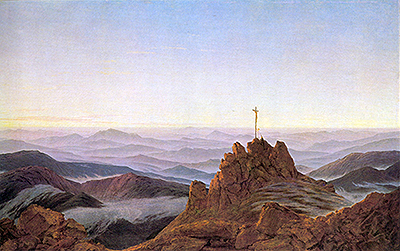Morning in the Riesengebirge is a stunning painting that exhibits Caspar David Friedrich exceptional skills and his fantastic ability to come up with detailed paintings.
Being one of the most famous painters in his generation, Caspar David Friedrich proves his unique understanding of the landscape by coming up with the Morning in the Riesengebirge. The painting was developed from the year 1810 to 1811, and it comes shortly after his visit with his friend Kersting to Saxon, a mountainous region near Dresden in Switzerland.
Just like his previous works, Caspar uses oil on canvas to come up with this fantastic painting. Morning in the Riesengebirge is where he goes ahead to prove his ability to come up with magnificent landscapes that are simple but detailed enough to look real. It also seems like a continuation of his previous works, such as the painting of the Tetschen Altar.
A glance at the art reveals a stunning mountainous landscape that extends further to the horizon. He uses his knowledge of landscape painting to showcase the rugged landscape and the huge number of mountains in the vicinity. The art is developed from a high ground that dwarfs the surrounding areas since from the location, it is easy to see the peaks of other mountains. The highlight of the painting is the cross, which stands majestically on a peak. He captures the rocky nature of the area surrounding the cross as well as the crucifix, but his main focus is on the environment. He artistically includes the mist, which shows the low temperature of the area, given that it is in the morning.
Further beyond the sun can be seen rising and slowly illuminating the areas around. The sky is perfectly painted with just enough details to make it appear real. Plain mountains cover the whole region is covered with no signs of human habitation. The angle he delivers the painting from gives the entire spectrum of the landscape, and that is what makes the painting one of his best works. Through the painting Morning in the Riesengebirge, it is clear that Caspar David Friedrich is a master of art with vast knowledge about landscapes. Due to its contents, the painting goes by many names, including Morning in the Giant Mountains, Area in the Morning Mist with a Crucifix, as well as, The Cross on Top of The Rocks.
In 1811, Frederick William III of Prussia acquired the painting after its exhibition at Dresden Academy. He placed the painting in his palace, Unter den Linden. In 1837, the painting was shifted to Neue Palais in Potsdam. It was then later exhibited in Schloss Bellevue, where it stayed from 1844 to 1865. The painting was later moved back to Berlin in 1930 and displayed at Stadtschloss. In 1857, Prussian State Museums acquired the painting as its property. The painting is currently hanged in Alte Nationalgalerie in Berlin.




